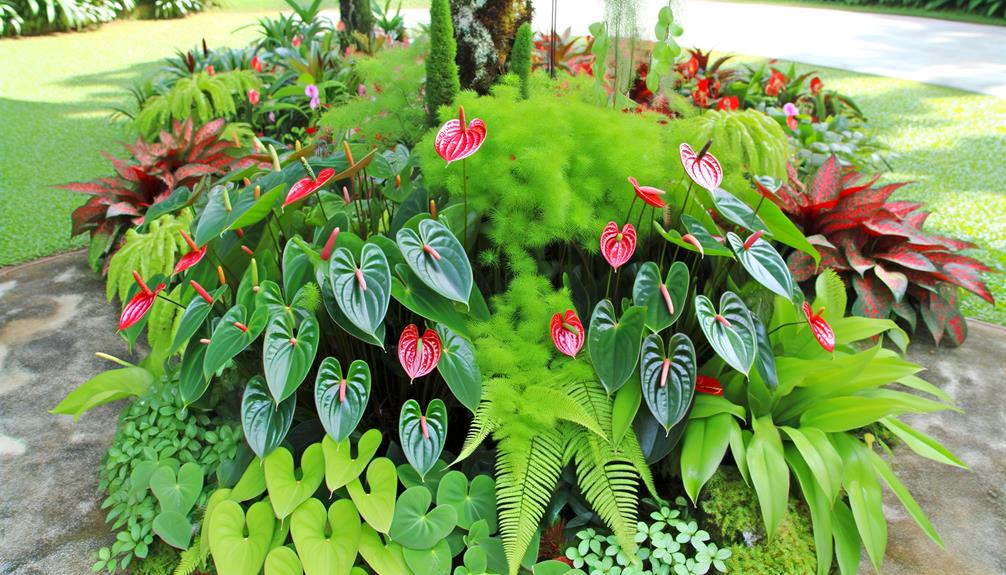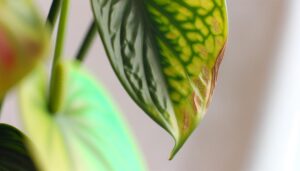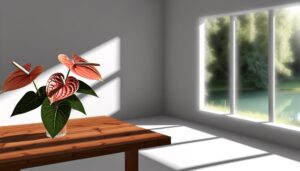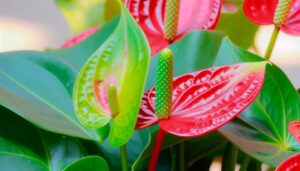3 Tips for Planting Anthurium With Other Plants
To plant Anthurium with other plants, follow these three tips: First, choose compatible plants like ferns and orchids that share similar light, water, and soil requirements. Guarantee all companion plants prefer a soil pH between 5.5 and 6.5.
Second, optimize soil by mixing peat, pine bark, and perlite for proper aeration and moisture retention. Position your Anthurium in filtered sunlight to avoid leaf burn.
Third, maintain humidity levels between 60% and 80% using a hygrometer and humidifier. Grouping plants can also help create a moisture-rich microenvironment.
Consider these factors for thriving plant companions and perfect plant harmony.

Key Takeaways
- Pair Anthurium with plants having similar light, water, and soil needs.
- Use well-draining soil mixes like peat, pine bark, and perlite for optimal growth.
- Maintain slightly acidic to neutral soil pH between 5.5 and 6.5.
- Ensure air humidity levels are between 60% and 80% using a hygrometer.
- Create a humidity-friendly microenvironment by grouping similar plants together.
Choose Compatible Plants
When choosing compatible plants to pair with Anthurium, consider species that share similar light, water, and soil requirements. For instance, ferns, such as the Boston Fern (Nephrolepis exaltata), thrive under similar conditions. Both plants prefer indirect light and high humidity, making them ideal companions.
Additionally, many orchids (Orchidaceae family) share Anthurium's need for well-draining soil and moderate watering schedules. Make sure that companion plants have similar pH preferences, typically between 5.5 and 6.5.
Avoid pairing with plants that require notably different care, as this can lead to suboptimal growth for both species. By matching plants with comparable needs, you create a harmonious environment that fosters healthy growth and vibrant foliage for your Anthurium and its companions.
Optimize Soil and Light
To maximize soil and light for Anthurium, it is essential to create the right conditions for the plant's growth. This involves attention to specific factors:
- Soil Composition: Use a blend of peat, pine bark, and perlite to ensure ideal aeration and moisture retention.
- Light Intensity: Position the Anthurium in an area that receives filtered sunlight, avoiding direct sun which can scorch the leaves.
- Soil pH: Maintain a slightly acidic to neutral pH (5.5-6.5) to support nutrient uptake.
Maintain Proper Humidity
Maintaining proper humidity is essential for Anthurium's growth, ensuring the air remains consistently between 60% and 80% relative humidity. To achieve this, you can use a hygrometer to monitor levels accurately. Placing a humidifier nearby or grouping plants together can create a microenvironment that retains moisture. Additionally, misting the leaves occasionally will provide temporary boosts in humidity. It's crucial to avoid over-watering, as Anthuriums are prone to root rot in excessively damp soil.
| Method | Description |
|---|---|
| Hygrometer | Measures humidity levels |
| Humidifier | Increases ambient humidity |
| Plant Grouping | Creates microenvironment |
| Leaf Misting | Temporary humidity boost |
| Proper Watering | Prevents root rot |
Conclusion
Think of your plant collection as a symphony; each element must harmonize for the best performance.
By choosing compatible plants, optimizing soil and light, and maintaining proper humidity, you're setting the stage for your anthurium and its companions to thrive.
Follow these tips, and you'll cultivate a vibrant, healthy ensemble.
Remember, the key to a flourishing garden lies in understanding each plant's unique needs and ensuring they work together in perfect balance.






